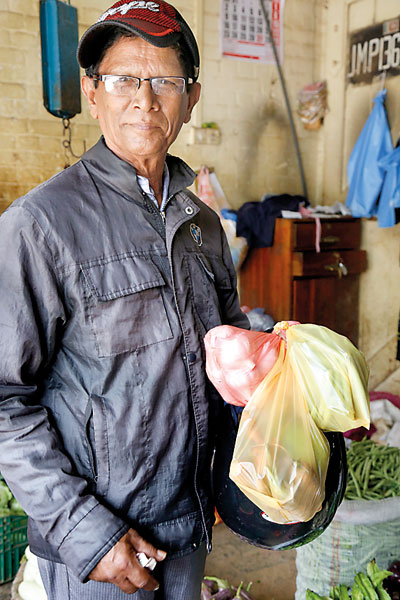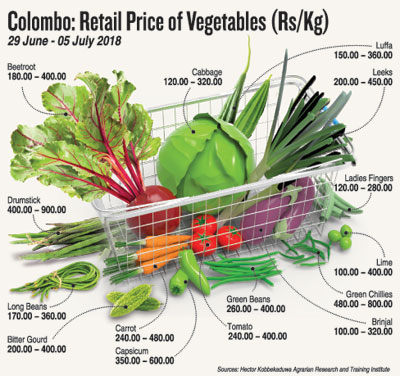News
Veggie surpluses and wild price fluctuations – the cycle continues
By the first week of June, prices of vegetables had increased substantially in the off season. Prices began to rise by early May as the harvest season was ending.

Narahenpita Jathika Pola: Not many customers
Earlier, there was a collapse in prices in the wake of massive surpluses. Farmers and vendors were seen dumping vegetables on garbage heaps and even handing out excess pumpkin for free. In mid-June, Agriculture Minister Mahinda Amaraweera famously said Sri Lankans should eat manioc and pumpkin because prices were low and that manioc is good for cancer.
The vegetable marketing system through dedicated economic centres is deficient, as is distribution.
Quality control is nearly non-existent and wastage is high. There is no mechanism for quality control. Farmers do not know what is required in the market and can’t plan their production. There is no mechanism for this either.
Producers barely make money, while middlemen lap up the profits.
Under the marketing heading, the Ministry of Agriculture’s agriculture policy document, merely says, “Promote the involvement of producers in agricultural processing and marketing;’’ and “Strengthen the supply chain management to develop an efficient agricultural marketing system’’.
The Ministry of Agriculture, under various politicians — from Duminda Dissanayake to Mahinda Amaraweera — has continued to offer knee-jerk, band-aid solutions, such as guaranteed prices for farmers, based on the news items of the day and agitations,
Farmers and researchers point to a number of anecdotal factors for the price and supply fluctuations. Government taxes on imported produce also contribute to high prices on items such as “Pakistan’’ and “Indian’’ potato.
A researcher at the Hector Kobbekaduwa Agrarian Research and Training Institute estimates that prices have risen by 50% compared with 25% to 30% in the past.
“From 2015, due to the drastic change in weather patterns, three consecutive cultivation seasons failed,’’ said P.A. Jayamini Champika, a researcher at the institute.
She notes that many paddy farmers have switched to cultivating vegetables and this led to overproduction of vegetables.
Heavy rains have also destroyed crops and created supply shortages that led to high prices.

Vegetables thrown away at the Narahenpita Jathika Pola. Pix by M.A. Pushpa Kumara
“Many farmers in our area have borrowed money and are heavily in debt,’’ said K.A.Surendra, who has been a farmer in Hambantota for the past 17 years.
He said many farmers do not know about climatic conditions and cultivation.
Many have given up farming and are trying their hand at jobs such as being carpenters.
“The important factor is to provide alternative knowledge about cultivation and the authorities must take the responsibility to create opportunities for farmers,’’ he said.
The national organizer of the All-island Farmers Federation, Namal Karunaratne told the Sunday Times that farmers are in a dilemma as they are unable to sell vegetables despite a market price. “Sri Lanka has to promote cultivation plans and educate farmers to cultivate the required amount of vegetables during a certain period,’’ he said.
There is also no cold storage in Sri Lanka.
“The production cost is high as a result of which many farmers are demotivated to grow and this broadly affects the agriculture industry,’’ he said.
“When vegetables become a staple in meals, rising prices are felt very badly by the consumers,’’ said Ranjith Vithanage, chairman of the National Movement for Consumer Protection Rights.
Not just climate issues, middlemen are also responsible for high prices, he said.

D. Palitha Wijemana: Bringing less vegetables to sell at the Narahenpita Jathika pola
Authorities must introduce efficient planning for the long-term to balance demand and supply.
Vendors in vegetable markets around Colombo both and consumers are trying to come to terms with high prices, losses, and purchase quantities.
M Bandara, who has been selling vegetables for the past 11 years said that when prices increased, garbage bins at the Narahenpita Economic Centre began filling up with vegetables.
“We used to transport 1,000 kilograms of vegetables every day but now it is only 600 kilos a day and sometimes a couple of kilos are thrown away,’’ he said.
George Reginton, a retiree from Mulleriyawa, said he buys less now at the market.
“We used to buy about a kilo when prices were much less. But now, we buy to 500 grams and we have cut down visits to the market,’’ he said.
D. Palitha Wijemana, a vendor at the Narahenpita Jathika Pola, who has been selling vegetables for the past 40 years, said he brings less to sell. He has noticed that some buyers are going to places where they can buy 100 grams of vegetables.
R. K. I. Hewage, a vendor at the Manning Market said that in his 18 years he has seen drastic price changes and that fewer people are coming to the market.
“We can only bring about two or three sacks of vegetables and whatever that is left we either sell it the next day, or sell it for a cheaper price to hotels,’’ he said.
D Kalinga, 55, from Kaduwela and a regular shopper at Manning Market said that despite the increase in prices of vegetables, she has to buy the usual quantity.
“We could purchase a bag full of vegetables for Rs 500, but now we must at least have Rs 2,000 in hand to fill a bag with vegetables,’’ she said. When prices are high, she only visits once a week.

George Reginton: Buying small quantities of veggies at the Manning Market
Consumer N D Lalith, 51, from Piliyandala has been severely affected by high prices.
“We are economically drained as the salary is spent on high-priced commodities, especially vegetables. At the end of the month, we borrow to eat,’’ he said.
At a supplier of 150 to 200 rice packets a day, costs have become a challenge, so they buy cheaper vegetables.
“Unlike in the previous years the cost of preparing lunch packs has increased,’’ an empployee said.
Meanwhile, authorities believe that by the end of this month, vegetables will become affordable.
According to officials of the Ministry of Agriculture, at a review held recently, the Agriculture Department has concluded that the recent vegetable price increase is due to the fluctuating weather conditions in the island.
However, the Ministry of Agriculture is preparing to set up alternative methods to store produce and to introduce new methods of growing vegetables.
W M D Wanninayake the media director of the ministry, said that the first cold storage will be built in Bandarawela as a pilot project.
Farmers will also be given advice about the use of polytunnels, which allow for cultivation during off season. On the 23rd of this month, 15 to 20 polytunnels will be introduced to farmers in Bandarawela.


